Cross Spread
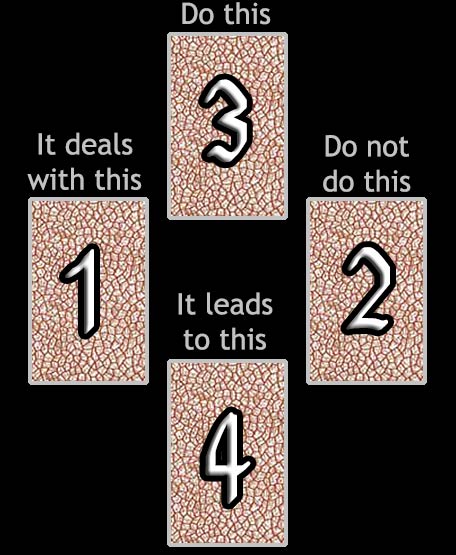
Difficulty: Easy
The Cross Spread is good for questions asking for advice. It can also be used to determine the meaning of a confusing card from a previous reading, or for that matter, to shed light on other points of confusion.
In questions asking advice, this tarot spread is self-explanatory. The main thing is to determine the difference between cards #2 and #3. #1 is the topic and #4 is the result.
In questions regarding confusion, such as: "What was the meaning of Card (X) in the last spread?" the main thing is also to determine the difference between cards #2 and #3. In this case, #2 will show what the card was not referring to, and Card #3 will show what was really meant. Card #1 is the topic and #4 represents the purpose it serves.
Your Cross Reading
DO This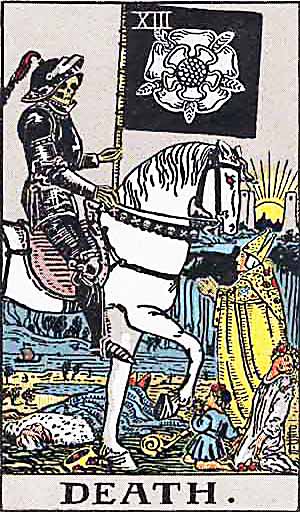 XIII – Death |
||
It Deals with This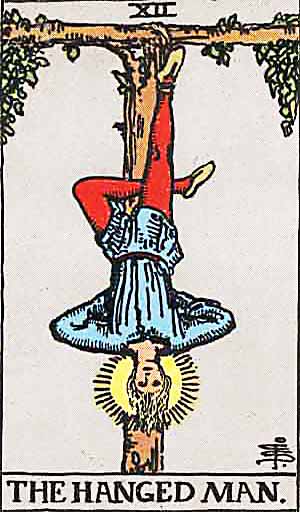 XII – The Hanged Man |
Do NOT Do This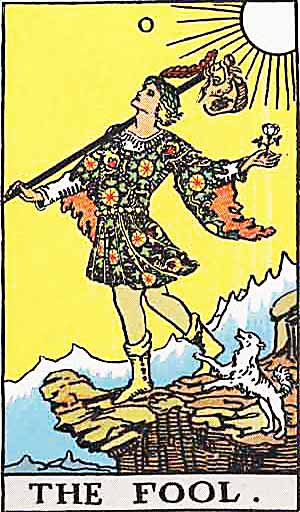 0 – The Fool, Reversed |
|
It Leads to This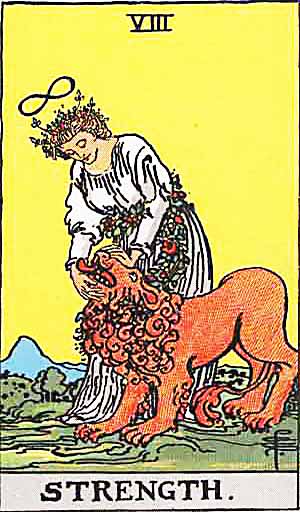 VIII – Strength |

It Deals with This
XII – The Hanged Man
The Hanged Man represents surrender, suspension, perspective, and letting go. This card embodies pausing to reflect and seeing life from a different angle. A figure hanging upside down by one foot signifies a period of stillness or suspension, where forward movement is halted and a new way of thinking must emerge. The figure's serene expression and the halo around his head suggest that this pause is not one of suffering, but an intentional and transformative moment of introspection. The Hanged Man teaches that sometimes we must detach from our usual way of living or thinking to experience growth, release, and enlightenment.
This card invites you to reconsider your current approach or perspective, suggesting that action alone cannot solve a situation or challenge, but through patience, acceptance, and a shift in viewpoint. The Hanged Man encourages the acceptance of temporary discomfort, trusting that letting go of control will ultimately lead to a more profound understanding of oneself and the situation at hand.
In Relationships: The Hanged Man suggests a time of reflection and reconsideration. It may indicate a need to pause and view the partnership from a different angle, possibly encouraging you to look beyond surface issues and explore deeper emotional truths. This card often points to a period of waiting or suspension, where things may feel stagnant or on hold, but where growth still occurs. The Hanged Man invites you to release expectations or rigid beliefs about love and instead be open to new perspectives and understandings. It also encourages self-sacrifice for the sake of the relationship, though with caution, ensuring the sacrifices made are not one-sided.
In Work: The Hanged Man points to a time of pause, reflection, or a shift in perspective regarding professional goals. It may suggest that you are in a phase where movement or progress is temporarily halted, and the key to success lies in rethinking your approach or strategy. This card advises patience and a willingness to let go of previous expectations or rigid plans to allow for new ideas and approaches to emerge. The Hanged Man can also indicate sacrifice or selflessness in your work, perhaps taking on a project or task that feels limiting or uncomfortable for the sake of a greater purpose or long-term gain. It teaches that growth often comes through patience and seeing things from a new angle.
Spiritually: The Hanged Man represents a necessary pause in one's spiritual journey, where the seeker is invited to let go of ego, attachments, and the need for control in order to achieve enlightenment. This card encourages you to release old beliefs, perspectives, and patterns to embrace a higher consciousness. The Hanged Man speaks to the process of surrender, where spiritual growth is achieved by stepping away from the material world and allowing oneself to be guided by faith, intuition, and trust in the universe. It is a reminder that some of the most profound spiritual growth occurs during times of stillness, waiting, or letting go.

Do NOT Do This
0 – The Fool, Reversed
The Fool represents the beginning of an inner and outer journey, a leap of faith into the unknown where infinite possibilities lie. This card embodies potential and purity. It represents the spirit of new beginnings before experience has shaped the self. The Fool carries a light knapsack, signifying that experiences or material attachments do not burden him. His innocence and openness suggest a state of trust in the universe and a readiness to take risks, unafraid of the unknown.
Reversed, the Fool can indicate a fear of stepping into the unknown, an avoidance of change, or a reluctance to take risks. It may suggest that you are holding back from starting a new journey because of doubts, insecurities, or an overreliance on the familiar. The Fool reversed warns against acting impulsively, leading to unnecessary mistakes. It can also signal naivety or a lack of preparedness when faced with challenges, urging you to approach new beginnings more responsibly.
In Relationships: The Fool invites openness, spontaneity, and fresh starts. This card suggests embarking on new romantic experiences without the weight of baggage. It encourages you to approach love with an open heart, ready to explore new connections and uncharted territory. The Fool signifies trust, freedom, and the joy of new beginnings, free from inhibitions.
In Work: The Fool signals a new chapter in one's professional life. It may indicate the start of an exciting journey or project, urging you to embrace change and take a risk for growth and fulfilment. This card encourages stepping out of your comfort zone, trusting that the journey will bring valuable experiences and opportunities despite an uncertain future. The Fool advises boldness and enthusiasm in pursuing career goals, suggesting that success may come from breaking away from conventional paths.
Spiritually: The Fool represents the call to venture beyond the ego, to explore new realms of consciousness and self-awareness. This card invites you to embrace the spiritual journey with innocence and trust, letting go of preconceived notions or rigid beliefs. The Fool encourages surrender to the flow of the universe, letting go of control, and embracing the unknown with faith. It is a reminder that the spiritual path is not about certainty, but the willingness to explore and discover.

DO This
XIII – Death
Death represents transformation, endings, and rebirth. It is a symbolic death, signifying the end of one phase of life and the beginning of another. A skeletal figure on horseback with a scythe reminds us that change is inevitable and letting go of the old makes room for the new. It signifies the natural cycle of life, where death is a transition, not an end. This card calls for releasing what no longer serves, allowing you to shed old habits or beliefs holding you back from growth.
Death may appear when you face a period of significant change or the need to release attachments. It encourages you to embrace these transitions with trust and understanding, knowing that they are part of the cycles of life. The end of something can be an opportunity for renewal, as old patterns give way to new possibilities. Death is not to be feared but embraced as a natural part of the journey of life.
In Relationships: Death signifies the end of a phase, which could be a breakup, a transformation in how two people relate, or letting go of old patterns that no longer work. This card indicates that the relationship may be going through a period of change, and it encourages you to embrace that change rather than resist it. Death invites rebirth—whether the opportunity to renew the relationship by letting go of baggage or the possibility of closing the chapter to make space for new, healthier connections. This card reminds us that endings, though painful, are necessary for growth and new beginnings.
In Work: Death signifies a major transformation, signalling the end of one chapter and the beginning of another. It may indicate the closing of a professional project, a career change, or a shift in goals or direction. While this may initially feel unsettling, Death suggests this change is an opportunity for growth through an alternative career path, a different role, or a fresh approach to work. This card encourages you to release old ways of working or thinking that no longer serve you and embrace the unknown with an open mind. Death signals that sometimes it's necessary to let go of the old to make space for new opportunities and success.
Spiritually: Death represents the ultimate transformation, the shedding of old identities, and the continual evolution of the soul. This card speaks to the process of spiritual rebirth, where you may be called to let go of outdated beliefs or practices that no longer resonate with your higher self. It encourages you to embrace the process of spiritual evolution, where each phase of life offers the opportunity to transform and grow in new ways. Death invites the seeker to release the attachments that bind them to the material world and focus on inner growth, understanding that spiritual evolution is a continual process of shedding and renewal.

It Leads to This
VIII – Strength
Strength represents courage, resilience, patience, and control. It embodies the power of taming inner fears, overcoming adversity with gentleness, and having the fortitude to face challenges with grace. A woman calmly holding the jaws of a lion signifies the balance between power and compassion, where strength comes not from force, but from a sense of inner calm and self-confidence. The woman's serene expression conveys that this strength is not aggressive, but is instead the ability to remain composed in the face of difficulty, harnessing personal power through self-discipline and understanding.
This card represents the courage to face life's challenges, persevere with patience, and trust in the process of growth. Strength reminds us that resilience is built from within, and that sometimes the greatest strength lies in showing vulnerability and compassion rather than exerting dominance. It is an invitation to approach difficult situations with kindness, both towards oneself and others, and trust that inner strength will carry you through.
In Relationships: Strength speaks to the power of patience, understanding, and unconditional love. It suggests you may be called upon to show compassion and support, particularly in times of difficulty or uncertainty. This card signifies the need for gentle, yet firm, emotional strength in navigating challenges, and reminds you that love is based on mutual respect, trust, and the ability to remain calm and supportive through all circumstances. It encourages you to act from a place of empathy, understanding that love is about partnership and compassion.
In Work: Strength represents the inner resilience needed to overcome obstacles and persevere in the face of professional challenges. It suggests your path to success will require patience, determination, and a steady hand in difficult situations. This card advises you to rely on your inner strength, confidence, and emotional intelligence to navigate challenges in the workplace, whether dealing with difficult colleagues, demanding tasks, or career setbacks. Strength encourages you to move forward with grace and conviction, trusting that inner resilience will lead you to success.
Spiritually: Strength signifies the mastery of the self, the ability to conquer one's inner demons, and the courage to follow one's spiritual path. This card calls you to dig deep within yourself for the fortitude to face your fears, heal emotional wounds, and cultivate peace. Strength emphasises that true power comes from compassion, inner harmony, and the ability to work through difficulties with faith and patience. It invites you to trust your spiritual journey and allow understanding to guide your growth.